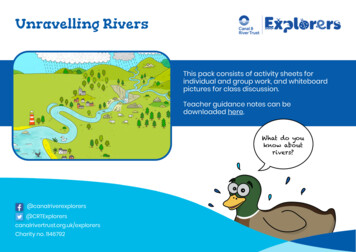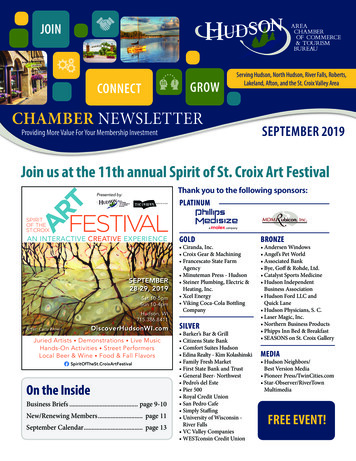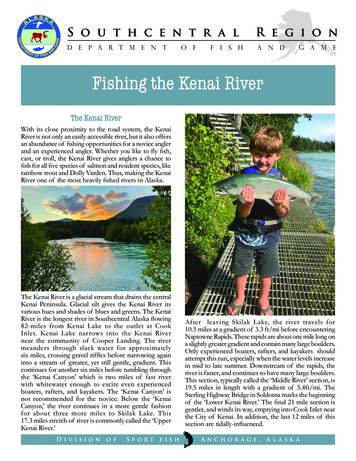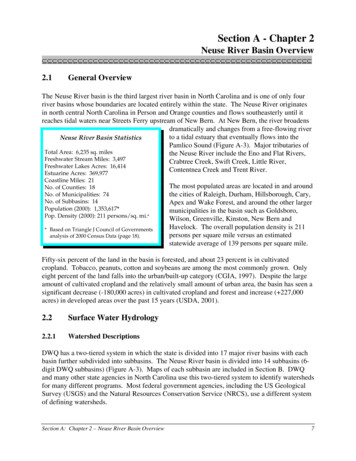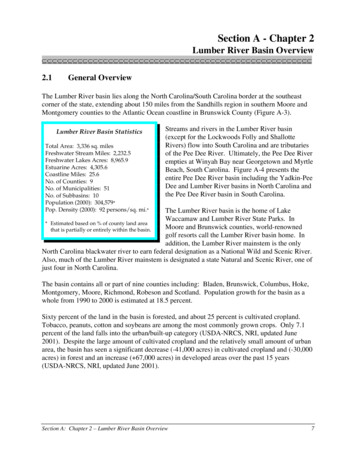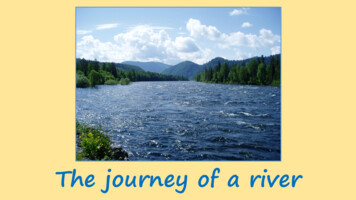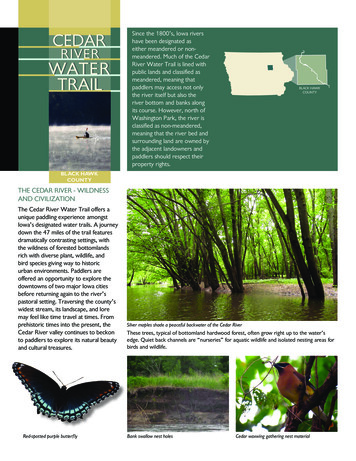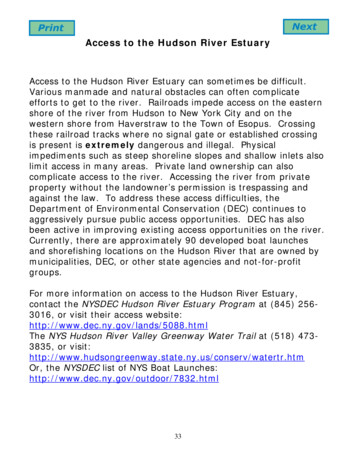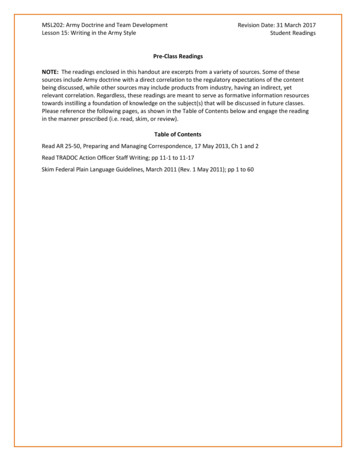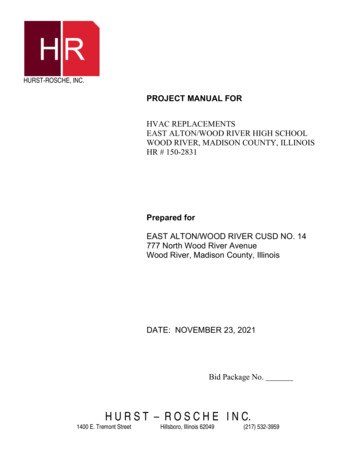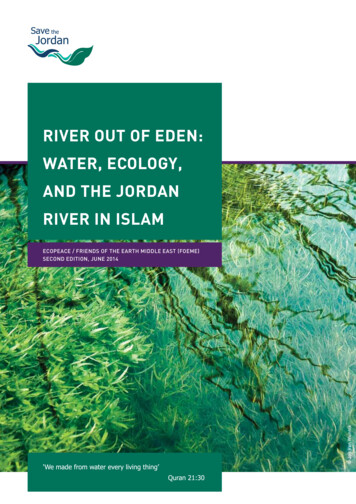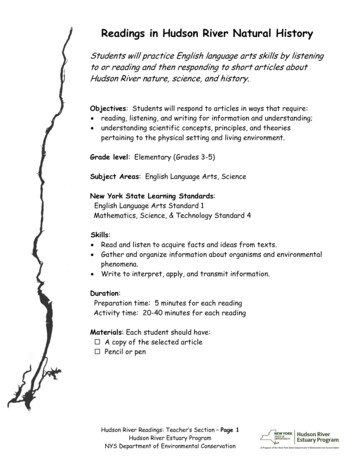
Transcription
Readings in Hudson River Natural HistoryStudents will practice English language arts skills by listeningto or reading and then responding to short articles aboutHudson River nature, science, and history.Objectives: Students will respond to articles in ways that require: reading, listening, and writing for information and understanding; understanding scientific concepts, principles, and theoriespertaining to the physical setting and living environment.Grade level: Elementary (Grades 3-5)Subject Areas: English Language Arts, ScienceNew York State Learning Standards:English Language Arts Standard 1Mathematics, Science, & Technology Standard 4Skills: Read and listen to acquire facts and ideas from texts. Gather and organize information about organisms and environmentalphenomena. Write to interpret, apply, and transmit information.Duration:Preparation time: 5 minutes for each readingActivity time: 20-40 minutes for each readingMaterials: Each student should have: A copy of the selected article Pencil or penHudson River Readings: Teacher’s Section – Page 1Hudson River Estuary ProgramNYS Department of Environmental Conservation
Background:The articles in this collection allow teachers to integrate instruction in reading andwriting with study of the Hudson River. Their content relates to organisms, events,and phenomena addressed in other lesson plans included in the Hudson River EstuaryProgram’s curriculum offerings. For example, the articles “The Atlantic Sturgeon ofthe Hudson River” and “Blue Claw” may be assigned to students who are also working onthe math skills lessons “On the Trail of the Hudson’s Migratory Fish” and “On the Trailof the Blue Crab.” The article “From the Mountains to the Sea” is intended to serve asa general introduction to study of the Hudson. Similar lessons for kindergarten tothird grade are available at http://www.dec.ny.gov/education/77601.html ; they offersimple activities as well as questions on the readings.Activity:1. Introduce the topic covered in the article.2. The articles can be read aloud to the class to practice listening skills or assigned asstudent reading, either in class or as homework.3. The questions associated with each articles may likewise be covered with the class,or given out as in-class work or homework.Assessment: Assess comprehension by having students share answers to questions about thearticles, or collect and grade sheets.Make up additional questions about the content of the articles.Resources:These children’s books cover the Hudson and related topics. Locker, Thomas. Where the River Begins. Puffin Books, New York: 1993.Appropriate for ages 4-8. Lourie, Peter. Hudson River: An Adventure From the Mountains to the Sea. BoydsMill Press, Honesdale, Pennsylvania: 1998. Appropriate for ages 9-12. McKinney, Barbara. A Drop Around the World. Dawn Publications, Nevada City,California: 1998. Appropriate for ages 4-8. Wallace, Karen. Think of an Eel. Candlewick Press, Cambridge, Massachusetts: 2004.Appropriate for ages 4-8. Whitcraft, Melissa. The Hudson River. Franklin Watts, a Division of GrolierPublishing, New York: 1999. Appropriate for ages 9-12.Hudson River Readings: Teacher’s Section – Page 2Hudson River Estuary ProgramNYS Department of Environmental Conservation
Vocabulary List:adapt: to develop a way of dealing with conditions in a particular environment;adaptation: a feature that allows an organism to deal with environmental conditionsalien: an organism from another part of the worldanadromous: lives in salt water but migrates back to freshwater to spawnbay: an inlet or small body of water set off from the main bodybehavioral adaptation: an adaption involving the way an animal actsbrackish: mixture of fresh and salt waterbrook: a small streamburrow: to dig a tunnel for shelter; also the tunnel itselfcamouflage: colors and patterns that let animals blend in with their surroundingscanal: a manmade waterway for boatscharacteristic: a special quality or appearance that makes an individual or groupdifferent from otherscurrent: water moving continuously in a certain directiondam: a barrier that holds water behind itdisplace: to take the place ofdownstream: in the direction a stream is flowingestuary: a body of water in which fresh and salt water meetevergreen: a tree with leaves that remain green all year roundexplorer: one who travels in search of new geographic or scientific informationfin: a thin extension of a water-living animal’s body, used in guiding its movementfresh water: water that is not salty (rainwater is fresh water)gill: in fish and other animals living in water, an organ used to draw oxygen from waterhabitat: the particular sort of place where a given plant or animal livesharbor: a body of water protected and deep enough to be a safe place for shipsintertidal zone: an area covered by water at high tide and uncovered at low tideinvasive: likely to spread and take overinvertebrate: an animal without a backboneHudson River Readings: Teacher’s Section – Page 3Hudson River Estuary ProgramNYS Department of Environmental Conservation
Vocabulary List (continued):lock: a water-filled enclosure used to lift or lower boats over a dam or along a canalmarsh: an area of shallow water with many plants growing through the water’s surfacemicroscope: an instrument that uses lenses to magnify images of very small objectsmigrate: to move from one place to anothermolt: to shed the shell covering the body and legsnative: an organism born in a particular place, not brought there from elsewhereorganism: an individual living thing (plant, animal, bacteria, etc)oxygen: a colorless, odorless gas found in the air and also dissolved in water; animalsrequire it to breathepermanent: unchanging; lastingphotosynthesis: process in which green plants use sunlight to make the chemicalsubstances that sustain themphysical adaptation: an adaptation involving the form of an organismpier: structure built out into the water for use as a docking place or walkwaypredator: an animal that eats other animalsrapids: part of a river that flows fast over and around rocks that break the surfacerepel: to resist and push awayriver: a natural stream of water larger than a brook or creeksalt water: seawater or other water that contains saltschool: a number of fish swimming together as a groupscientist: a person skilled in sciencesea level: the average height of the oceanseawater: salty ocean watersenses: parts of an organism that make it aware of its surroundings; usually sight,smell, taste, hearing, touchshoreline: the line where a body of water touches the shorespawn: to lay eggs; usually refers to animals that live in waterspiny: having stiff, thorn-like pointsstream: a small body of running waterHudson River Readings: Teacher’s Section – Page 4Hudson River Estuary ProgramNYS Department of Environmental Conservation
Vocabulary List (continued):symbol: something that stands for something elsethreatened: an animal or plant that exists in such low numbers that care must be takento keep it from dying outtidepool: a pool of water left when the tide recedestides: the alternate rising and falling of the surface of the oceantransmitter: a device that sends out signalstransparent: see-throughupstream: in the direction from which a stream is flowingvoyage: a journey, usually by water, from one place or country to anotherHudson River Readings: Teacher’s Section – Page 5Hudson River Estuary ProgramNYS Department of Environmental Conservation
This page intentionally left blank.
From the Mountains to the Sea: ANSWER KEY1. This article is mostly abouta. how people use the Hudson Riverb. the kinds of fish that live in the Hudson Riverc. the course of the Hudson Riverd. Lake Tear of the Clouds2. Where did the Hudson River get its name?a. from an explorerb. from a Native Americanc. from a fish found in the sead. from an estuary3. What is an estuary?a. a stream with rapids and waterfallsb. a place where fresh water and salt water mixc. a kind of shipd. a water route to Asia4. Where does the Hudson River begin its journey?a. the City of Troyb. the Adirondack Mountainsc. the Hudson Highlandsd. the Atlantic Ocean5. Do you think the Hudson goes over any waterfalls between the dam atTroy and the Atlantic Ocean? Why or why not?No waterfalls. The Hudson is at sea level from Troy to the Atlantic; tidesgo all the way to the Troy dam.6. Challenge question: Why do you think Henry Hudson decided that this riverdid not lead all the way to China?The river water changed from being salty like seawater to being fresh.Rapids and waterfalls blocked Hudson’s ship.Hudson River Readings: Teacher’s Section – Page 5Hudson River Estuary ProgramNYS Department of Environmental Conservation
Atlantic Sturgeon of the Hudson River: ANSWER KEY1. This article is mostly abouta. fish that lay eggsb. a fish called the Atlantic sturgeonc. different shapes and sizes of fishd. striped bass and American shad2. What does it mean to be an anadromous fish?1. a fish that eats at the bottom of the river2. a fish that lives more than sixty years3. an animal living in the water4. a fish that migrates between fresh water and the ocean3. What does it mean for fish to spawn?a. fish swim to the oceanb. fish swim into the Hudson Riverc. fish lay eggsd. fish eat crabs, mussels, worms, and insects4. According to the article, which of these statements are true?a. The Atlantic sturgeon is the largest fish in the Hudson. TRUEb. The Atlantic sturgeon spawns in the Atlantic Ocean. FALSEc. The Atlantic sturgeon dies after spawning only once. FALSEd. The Atlantic sturgeon is an anadromous fish. TRUEHudson River Readings: Teacher’s Section – Page 6Hudson River Estuary ProgramNYS Department of Environmental Conservation
Bald Eagles of the Hudson River: ANSWER KEY1. What is this article mostly about?a. migrationb. the bald eaglec. fishd. the Hudson River2. Which definition best describes migration?a. to stay in one placeb. to live on the Hudson Riverc. to move from one place to anotherd. to find plenty of food3. According to the article, how many days would it take an eagle to migrate1,000 miles between its nesting area in Canada and its winter home on theHudson?Eagles may travel up to 100 miles in a day, so it would take 10 days.Younger students can count by 100s to find the answer. Older studentsmight use multiplication or division.4. Why do you think bald eagles cannot find their favorite food in northernCanada during the winter?Ice prevents eagles from catching fish.5. Challenge question: Hold your arms straight out to both sides. Have apartner use a tape measure to measure the distance between your fingertips –your “wingspan.” Is your wingspan more or less than an eagle’s? How much moreor less?An eagle’s wings may measure seven feet from tip to tip.(It may be helpfulto convert feet to inches first – seven feet equals 84 inches.) If astudent’s “wingspan” is less than an eagle’s, subtract it from seven feet tofind out how much less. In the (unlikely) event that a student’s wingspanexceeds an eagle’s, subtract seven feet from the student’s wingspan to findout how much greater the student’s wingspan is.Hudson River Readings: Teacher’s Section – Page 7Hudson River Estuary ProgramNYS Department of Environmental Conservation
The Eel’s Incredible Journey: ANSWER KEY1. This article is mostly abouta. the Sargasso Sea.b. the life cycle of the American eel.c. different shapes of fish.d. glass eels.2. Based on the article, when an eel’s color turns silvery, the fish is ready toa. migrate from the Sargasso Sea to the coast of North America.b. become an elver.c. migrate to the Sargasso Sea to spawn.d. swim up rivers into fresh water.3. Scientists know that the eel spawns in the Sargasso Sea becausea. that is where the smallest baby eels are found.b. silver eels have been caught there.c. eel eggs have been found there.d. elvers have been seen there.4. According to the article, which of the following statements are true?a. The American eel is a kind of snake. FALSEb. American eels live in both fresh and salt water. TRUEc. Some American eels live for more than twenty years. TRUEd. Glass eels are brown, green, or yellow in color. FALSE5. Do you know of any other fish that migrate?The Atlantic sturgeon (subject of another ELA article in this lesson planseries), striped bass, and American shad are among the Hudson River fishthat migrate. Some students will likely be familiar with the migration ofsalmon, which are not native to the Hudson.Hudson River Readings: Teacher’s Section – Page 8Hudson River Estuary ProgramNYS Department of Environmental Conservation
Blue Claw! ANSWER KEY1. Including claws and paddles, how many legs does a blue crab have?Ten.2. As a crab molts, which of the following things happen?a. Its body grows larger.b. It sheds its shell.c. Its body becomes soft.d. All of the above things happen.3. The blue crab’s large claws are used fora. catching food and defending itself.b. swimming.c. walking.d. molting.4. According to the article, which of the following sentences are true?a. Blue crabs can swim. TRUEb. When molting, the body of a blue crab may change form. TRUEc. A tiny baby blue crab looks like its parents. FALSE5. Challenge question: When going out to eat seafood, you might see softshelled crabs listed in the menu. These are actually blue crabs, not a differentkind of crab. These crabs would just have gone through what part of their lifecycle? Use facts from the article to explain your answer.Soft-shelled crabs are adult crabs that have just molted. Their bodiesfeel like soft rubber. People who are very familiar with blue crabs canrecognize crabs that are about to molt, and larger seafood companies willkeep these crabs in holding pens. When they molt, these crabs are sold assoft-shelled crabs.Hudson River Readings: Teacher’s Section – Page 9Hudson River Estuary ProgramNYS Department of Environmental Conservation
Adaptations – Designs for Survival: ANSWER KEY1. What is an adaptation?Something that helps an organism do the things it must do to survive in itsenvironments.2. Give two examples of animal adaptations from the article. Explain how eachhelps the animal survive.Catfish whiskers have taste buds that allow the fish to find food in thedark. The patterns and colors of an owl’s feathers allow the bird to blendin with its surroundings. Monarch butterflies have warning coloration toremind predators of their bad taste. Monarchs also migrate to avoidwinter. Shad swim in schools, in which the large number of swirling fish canconfuse predators.3. Is each of the following a physical or behavioral adaptation?(All of these organisms live in the Hudson Valley.)(a) a map turtle’s shell.A physical adaptation thatprotects the turtle’s body.(b) beavers building dams.A behavioral adaptation thatcreates ponds to shelter thebeaver from predators.(c) prickly pear cactus spines.A physical adaptation thatprotects the cactus frombeing eaten or disturbed bylarge animals.(d) a black bear’s deep wintersleep. A behavioral adaptationfor surviving winter.Hudson River Readings: Teacher’s Section – Page 10Hudson River Estuary ProgramNYS Department of Environmental Conservation
Adapting to Estuaries: ANSWER KEY1. This article is mostly abouta. plants of the Hudson Riverb. how animals and plants adapt to habitats in the Hudson estuaryc. the tides in the Hudson Riverd. fish migration2. Which of the following cause conditions in Hudson River habitats to change?a. tidesb. seasonsc. salty seawater entering the estuaryd. all of the above3. Fill in the blank to complete the following sentences.a. Barnacles close their shells to keep water inside when the tide is low .b. Yellow perch live in fresh water.c. The osprey migrates south when winter comes to the Hudson.d. Spatterdock plants can survive being covered with water at high tideand exposed to the air at low tide.4. According to the article, why do plants grow where they do in the Hudson?Where a plant grows along the Hudson depends on how well it can survivebeing flooded at high tide or being out in the air at low tide.5. Challenge questions. Extend what you learned from the article to answerquestions about the Hudson River animals picturedbelow. Explain your answers.a. Where does the map turtle spend the winter?This turtle burrows into the mud of the river bottom.b. The pearly mussel breathes underwater. How does it survivebeing exposed to the air at low tide?At low tide, it closes up tight to keep water inside its shell.c. The green heron eats fish and frogs. When winter comes, whatdoes it do to survive?The heron migrates south to places where ice doesn’t coverthe water in winter.Hudson River Readings: Teacher’s Section – Page 11Hudson River Estuary ProgramNYS Department of Environmental Conservation
Alien Invasion! ANSWER KEY1. This article is mostly abouta. aliens from outer space.b. an invasive plant.c. animals that live in water chestnut mats.d. the dangers of water chestnut seeds.2. What does it mean to be an alien species?a. one that damages the environment.b. one that lives in Europe or Asia.c. one that is invasive.d. One that grows in a place where it didn’t live until people brought itthere.3. Water chestnut is an invasive species becausea. it displaces native plants that grow in shallow waters of the Hudson.b. the spines of the water chestnut seed can stab people’s feet.c. it comes from Europe and Asia.d. its leaves float on the surface of the water.4. According to the article, which of these statements are true?a. It is dark beneath thick mats of water chestnut leaves. TRUEb. Many insects, crustaceans, and worms live on water chestnut. TRUEc. Water chestnut is found in salt water. FALSEd. “Devil’s heads” are the seeds of the water chestnut plant. TRUEHudson River Readings: Teacher’s Section – Page 13Hudson River Estuary ProgramNYS Department of Environmental Conservation
Name DateRead the following article and answer the questions.Lake Tearof the CloudsADIRONDACKMOUNTAINSFrom the Mountains to the SeaHigh in the Adirondack Mountains,surrounded by evergreen trees, is alittle pond called Lake Tear of theClouds. The tiny brook that flows fromLake Tear is starting a journey 315miles long. Joining with many otherstreams, it will become the mightyHudson River flowing to New YorkHarbor.Lake Tear of the CloudsGlensFalls**FortEdward* TroyThe Hudson in the AdirondacksAt first, the Hudson rushesdownhill over waterfalls andrapids. The water from Lake Teardrops 4,000 feet as its coursewinds through the Adirondacks tothe city of Glens Falls.Closing the gates of a lockThe lock fills withwater, raising the boat.In Fort Edward, a few milessouth of Glens Falls, theHudson becomes a canal. Theriver flows downstream over aset of dams, each with a lockthat raises or lowers boatsfrom one section of the river tothe next.HUDSONHIGHLANDSNWES* New York CityATLANTIC OCEANFrom the Mountains to the Sea. Page 1
The last of these dams and locksis at Troy. When the Hudson goesover this dam, it drops almost to sealevel. Even though the AtlanticOcean is more than 150 miles away,it influences the river all the way toTroy. The water level here goes upand down with ocean tides. Theseare the same high and low tides thataffect beaches on Long Island andthe New Jersey shore.The Hudson HighlandsHigh tide below the Troy DamLow tide below the Troy DamCloser to the Atlantic, the river flows throughmountains called the Hudson Highlands. Here the oceanstarts to influence the Hudson in another way. Seawaterpushes into the Hudson and mixes with fresh water,making the river taste slightly salty. This mix of saltand fresh water is called brackish water. Places wherethis mixing occurs are called estuaries.The Hudson River at New York CityThe Hudson River estuary becomes saltier as it nears New York City and theAtlantic Ocean. Here people catch flounder and other fish of the sea. Cruise shipssail in from the ocean to dock at river piers.Perhaps the estuary’s brackish water and tides gave the explorer Henry Hudsonhope that this river would lead to the Pacific Ocean and China. He sailed up theriver on his ship the Half Moon in 1609. He was disappointed in the end, but hisvoyage was remembered. This great river flowing from the Adirondacks to theAtlantic was named after him.From the Mountains to the Sea. Page 2
Name Date1. This article is mostly abouta. how people use the Hudson Riverb. the kinds of fish that live in the Hudson Riverc. the course of the Hudson Riverd. Lake Tear of the Clouds2. Where did the Hudson River get its name?a. from an explorerb. from a Native Americanc. from a fish found in the sead. from an estuary3. What is an estuary?a. a stream with rapids and waterfallsb. a place where fresh water and salty ocean water mixc. a kind of shipd. a water route to Asia4. Where does the Hudson River begin its journey?a. the City of Troyb. the Adirondack Mountainsc. the Hudson Highlandsd. the Atlantic Ocean5. Do you think the Hudson goes over any waterfalls between the dam atTroy and the Atlantic Ocean? Why or why not?6. Challenge question: Why do you think Henry Hudson decided that thisriver did not lead all the way to China?From the Mountains to the Sea. Page 3
This page intentionally left blank.
Name DateRead the following article and answer the questions.The Atlantic Sturgeon of the Hudson RiverScientists catch an adult Atlantic sturgeon.The Atlantic sturgeon is the largest fish in the Hudson River. Adults are oftenfive to eight feet long. Is that bigger than you are? The biggest Atlantic sturgeonon record was caught in Canada. Fourteen feet long, it weighed eight hundredpounds! That equals the weight of 15 fourth graders!Sturgeons have rows of bony plates along their bodies, and a mouth like avacuum cleaner. They eat crabs, mussels, worms, and insects on the bottom.The Atlantic sturgeon is born in fresh water and spends the first years of itslife in the Hudson. Then this fish swims out into the Atlantic Ocean. Scientistsknow little about how the sturgeon spends its time at sea except that it doestravel far. Hudson River sturgeons have been found as far south as North Carolinaand as far north as Massachusetts.When Atlantic sturgeons are teenagers, they swim back up the Hudson intofresh water. There they lay eggs; this behavior is called spawning. Then the fishreturn to the ocean. This journey back and forth between river and sea is anexample of migration. Atlantic sturgeons repeat this migration every three yearsfor the rest of their lives. They can live more than sixty years.Like the Atlantic sturgeon, the Hudson’s striped bass and American shad areborn in fresh water, swim out into the ocean, and then migrate back to the river tospawn. This is called an anadromous life cycle.The Atlantic Sturgeon of the Hudson River. Page 1
1. This article is mostly abouta. fish that lay eggsb. a fish called the Atlantic sturgeonc. different shapes and sizes of fishd. striped bass and American shad2. Whata.b.c.d.does it mean to be an anadromous fish?a fish that eats at the bottom of the rivera fish that lives more than sixty yearsan animal living in the watera fish that migrates between fresh water and the ocean3. Whata.b.c.d.does it mean for fish to spawn?fish swim to the oceanfish swim into the Hudson Riverfish lay eggsfish eat crabs, mussels, worms, and insects4. According to the article, which of these statements are true?a. The Atlantic sturgeon is the largest fish in the Hudson.b. The Atlantic sturgeon spawns in the Atlantic Ocean.c. The Atlantic sturgeon dies after spawning only once.d. The Atlantic sturgeon is an anadromous fish.Scientists caught and released this young Atlantic sturgeon nearHaverstraw, New York. It had not yet left the Hudson for the ocean.The Atlantic Sturgeon of the Hudson River. Page 2
Name DateRead the following article and answer the questions.Bald Eagles of the Hudson RiverAn adult bald eagleThe bald eagle is found all over North America, from Alaska and Canada tonorthern Mexico. Along the Hudson River there are two different groups of baldeagles. One group is made up of eagles that nest along the Hudson and stay here allyear. The other group of eagles travels south from Canada and New England tospend the winter here. These birds will fly back north in spring. This movementfrom one place to another is called migration.Scientists attach lightweight radio transmitters to eagles. The transmitterssend signals that scientists follow to track the birds’ migrations. Bald eagles maytravel up to 100 miles in a day. Some migrate more than 1,000 miles between theirsummer and winter homes. Bald eagles fly south in cold weather to find open waterand food. Fish is this eagle’s favorite food, but it will also eat ducks and mammals.Eagles are very large birds. They can be three feet long with wings measuringseven feet tip to tip! An adult bald eagle is easy to identify. It has a white head,white tail, and large yellow beak. Young birds do not have the white head and tail,and are mostly brown in color.The bald eagle is the symbol of the United States. The government hasclassified this bird as a threatened species. This means that the number of eaglesis low, and they should not be harmed in any way.Bald Eagles of the Hudson River. Page 1
1. What is this article mostly about?a. migrationb. the bald eaglec. fishd. the Hudson River2. Which definition best describes migration?a. to stay in one placeb. to live on the Hudson Riverc. to move from one place to anotherd. to find plenty of food3. According to the article, how many days would it take an eagle to migrate 1,000miles between its nesting area in Canada and its winter home on the Hudson?4. Why do you think bald eagles cannot find their favorite food in northern Canadaduring the winter?5. Challenge question: Hold your arms straight out to both sides. Have a partneruse a tape measure to measure the distance between your fingertips – your“wingspan.” Is your wingspan more or less than an eagle’s? How much more or less?This baby eagle was born in a nestoverlooking the Hudson River.Bald Eagles of the Hudson River. Page 2
Name DateRead the following article and answer the questions.The Eel’s Incredible JourneyHave you ever seen a fish that looks like a snake? If so, you have probablyseen an eel. Unlike snakes, eels have fins and breathe with gills instead of lungs.The Hudson River and other waters in New York are home to the Americaneel, but it is not born here. Its birthplace is in the Sargasso Sea, part of theAtlantic Ocean southeast of Bermuda. From the Sargasso Sea, ocean currentscarry baby eels to the coast of North America. This trip takes many months.At first, baby eels look like bits ofclear tape a few inches long. As theyoung fish leave the ocean currents andswim towards the coast, their bodies become more like pieces of spaghetti.However, they remain transparent and are called glass eels. Only the tiny blackbeads of their eyes and their red gills are easily seen.Glass eelsSome eels stay in salt water and live inbays and marshes along the coast.Others swim up rivers to live infreshwater habitats. Soon afterarriving in these new habitats, green,brown, or yellow colors begin to appear ontheir bodies. At this point they are calledelvers.The Eel’s Incredible Journey. Page 1
American eels may live in bays, rivers, and streams for twenty years ormore. But when the time comes to spawn (lay eggs), they undergo anotherchange. Their eyes grow larger, and their color becomes more silvery. Thesesilver eels swim downstream and out to sea, journeying back to the SargassoSea. There they complete their life cycle by spawning and then dying.For centuries, the location where eels were born was a mystery. Even today,no one has ever seen eels spawning in the Sargasso Sea. Matter of fact, noadult eels or eggs have been found there. So how do we know that this is whereeels are born? Scientists have used nets with very fine mesh to capture youngeels all over the Atlantic Ocean. The very smallest ones—eels that have justhatched—are caught in the Sargasso Sea.1. This article is mostly abouta. the Sargasso Sea.b. the life cycle of the American eel.c. different shapes of fish.d. glass eels.2. Based on the article, when an eel’s color turns silvery, the fish is ready toa. migrate from the Sargasso Sea to the coast of North America.b. become an elver.c. migrate to the Sargasso Sea to spawn.d. swim up rivers into fresh water.3. Scientists know that eels spawn in the Sargasso Sea becausea. that is where the smallest baby eels are found.b. silver eels have been caught there.c. eel eggs have been found there.d. elvers have been seen there.4. According to the article, which of the following statements are true?a. The American eel is a kind of snake.b. American eels live in both fresh and salt water.c. Some American eels live for more than twenty years.d. Glass eels are brown, green, or yellow in color.5. Do you know of any other fish that migrate?The Eel’s Incredible Journey. Page 2
Name DateRead the following article and answer the questions.Blue Claw!Do you know what a crab looks like? Perhaps you have seen one down at theHudson River. Which of these pictures shows a crab?Picture #1Picture #2Picture #3If you guessed Picture #3, you would be right. This is a grownup blue crab,also called a blue-claw crab. Its two front legs are big claws for catching foodand fighting off predators. Its two back legs are paddles for swimming. Thecrab uses its other six legs to walk over the river bottom.If you guessed Picture #2, you would also be right. This is a very young bluecra
in the direction from which a stream is flowing . voyage: a journey, usually by water, from one place or country to another . Hudson River Readings: Teacher's Section - . The river water changed from being salty like seawater to being fresh. Rapids and waterfalls blocked Hudson's ship. Hudson River Readings: Teacher's Section -
